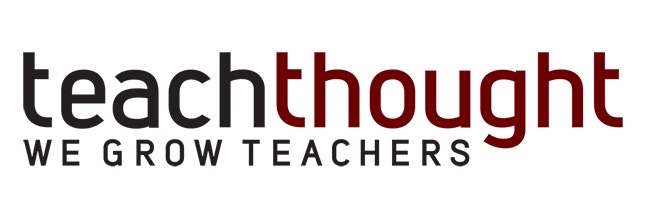
10帮助学生从他人那里学习的方法比对您的学习更多
经过特里·希克(Terry Heick)
谁控制教室里的学习?该学习的来源是什么?学习是否是因为获得内容的访问或参与教师衍生的学习活动而发生的?在学习过程中,谁或最持续的催化剂是什么?
通常,可能是您(老师)。您是内容和教学法的专家。您知道正在学到了什么,以及如何最好地学到它。在自己的学习中为学生提供充分的自主权可能对动机来说是可以的,但这可能是一个问题,出于各种原因。老师是有限的。老师有限。老师有“自我偏见” - 无论他们多么努力表现出同理心,都可以从他们的角度看。在以教师为中心的教室里,老师是瓶颈。(以下是一些例子以学生为中心的学习)
这表明将它们连接到其他人,平台和社区,这是答案的一部分。但这并不是那么简单。这意味着“失衡”的种类很重要。如果一个学生已经开始研究和出版他们的家谱并遇到问题,那么他们的习惯是什么?他们如何回应?作为一名教育者,这既是实用的(就教学的实践而言)和情感(就您与学生的关系而言)。教学和学习是自然失衡的过程。也就是说,他们倾向于提升一侧(用Vygotsky的语言,更知识渊博的其他语言),而另一方则变得顺从。或至少有需要。
传统上,“ MK”一直是老师,而“ LK”(知识渊博)的学生。老师还管理教室的纪律和工作流程,这一事实使它变得更加方便甚至不可见。在连接主义者学习模型和环境中(假设您使用它们),它可能不是老师。它可能是导师,社区成员或专家。实际上,在点对点或学校对学校学习模式中,它甚至可能不是成年人。这表明了教学和学习方式的一些调整。
如何帮助学生从任何事物中学习:两种帮助学生从他人那里学习的方法比对您的学习更多
1.确定才能,天才和优势(T/G/S):首先,确定学生的固有优势和自然才能。在主题中,您会在下面看到继续,帮助他们自己识别它们…
- 他们的才华,天才和优势的例子(T/G/S)
- 他们的t/g/s的属性
- 他们的T/G/S的来源
- 他们的t/g/s的影响
- 其T/G/S的潜在用途
2.创建学习的生态系统:通过这些才能,天才,优势甚至特征,将学生彼此联系起来(例如,感情)。Whether it’s creative (e.g., painting), specific knowledge (e.g., advanced understanding of math), skill-based (e.g., athletics, music, etc.), geography-based (e.g., rural learners connecting to other rural learners–or the opposite, rural to urban and vice-versa), connecting students.
And note, this doesn’t mean that students that ‘draw well’ should simply go hang out with other students that ‘draw well.’ Though that’s possible, it also could be that the student that ‘draws well’ connect with a student that ‘codes well’ and another student that ‘plays the violin well’ to identify shared opportunities to grow as individuals–and create a better world in the process. The big idea here is sustainability by creating an ecosystem of learning that is based on creativity, interest, and possibility as brought to bear by students on topics, problems, and opportunities they care about.
3.型号基于激情的学习:如何问一个好问题,如何批判性地思考主题,以及如何利用人类的激情和好奇心来维持随着时间的推移的询问,从而导致终身学习和人类成长。
4.价值(和奖励)对内容的好奇心:您是在教书或教学思想吗?这是改变一切的重要区别。同时,您是否在好奇心上重视内容掌握的内容?的确,它们不必相互排斥,但是根据设计,您要实现什么,您可以指出什么是证明它确实是“设计”?
这个概念可以双向发展 - 感兴趣的内容可以促进好奇心,因为好奇心可以导致有趣的内容。但是,大局,好奇心是知识和知识应用的策略和框架,而知识本身没有前者。这里有一些帮助学生学会问好问题的想法。
5.将学习者与有趣的事物联系起来:然后走开。The world is an amazing place–a lot of the ‘learning from anything’ and ‘learning more from other people than they do from you’ can be reduced to uncovering cool things (bridge design, brain surgery, agrarian principles, etc.), and then only stepping in when you see they need ‘something’ (see #8 below).
And once you’ve done so, don’t ‘school it up’ with a bunch of meaningless work and letter grades, or you’re defeating the whole purpose of creating learners that manage themselves, learn for themselves, and direct their own truly personalized learning pathways. See also为什么学生不知道的事比他们做什么更重要vwin.com德赢。
6.帮助学习者看到每个人都有某物去教:这可以通过以“非传统”方式研究人们以及出于“非传统”原因来实现。了解他人可以增加同理心,但也可以为增长提供模型。传记在这里可以很有用,但是帮助他们创建自己的传记甚至更好,因为它可以帮助学习者通过具有有意义和感兴趣的镜头来构图。For example, rather than reading a glossy biography that provides an overview of a life, where they were born and raised, and maybe identifying a challenge the person had to overcome, students instead might study someone–one of ‘the greats’– who exemplify specific characteristics, contexts, or virtues that resonate with the student.
Maybe Michael Jordan doesn’t ‘resonate’ with a modern student who never got to see the basketball great in his prime, but examining Jordan through the lens of sacrifice–how he cut the webbing between his fingers so that he could palm a basketball, or retired from basketball at the peak of his abilities in order to pursue a baseball career after the death of his father–is more authentic and more useful. It also allows students to learn something from everyone, providing a method of examining even deeply flawed individuals to extract lessons, learn from mistakes, etc.
穆罕默德·阿里(Muhammad Ali),约翰·肯尼迪(John F.士兵,农民或艺人。主要或晦涩的历史人物或音乐家。这些是与年轻学习者具有信誉的人。帮助学习者通过某些镜头(打动和所有人)检查人们,可以帮助他们创建更全面的照片,即“谁”和“什么” - 他们正在努力变得像。
7.帮助他们反思自己的学习:帮助学生反思他们学到的知识,如何成长,他人如何学习和成长,与谁建立联系以及如何等待等等。8反思性问题,以帮助任何学生思考他们的学习。反思对于出于多种原因学习至关重要,包括如何帮助阐明成长和学习者的机会,而学习者原本可能错过,理所当然,被误解,未能欣赏等等。
8.给他们来源,工具,策略,框架和学习资源:我可以继续使用这样的列表,但是我已经接近了1200个字,所以我将以这一单词结尾。不管有趣的话题,照亮的礼物,共同的相互依存,提供机会,引人入胜的传记模型等。 - 没有练习和记录学习的方法,手段和方法,进步可能会很慢。Whether it’s a book, app, athletic team, video game, organizational membership, paintbrush, laptop, writer’s desk, blog, garden, sewing machine–or even less-tangible things like encouragement, schedules, to-do lists, etc.–the ‘ecosystem’ of learning we talked about earlier could lack the catalysts to maintain growth over time.
9.使用指导 - 不仅是成年人,而不仅仅是“职业”:This one is a little redundant, but the distinction here is to not just allow students to connect with other students (like #2) or ‘study people’ (like #6), nor even follow professionals from a specific field in order to get ‘career advice,’ but rather to connect different people of different age and social groups for different reasons to have different experiences that enrich their cultural and human context: Who they are, who they are connected to, and what that connection requires and suggests.
10.帮助他们自己定义质量:否则,他们可以接受培训,以寻找余生的外部验证,并试图被告知他们“擅长”某些东西,而不是想要和学会出于强大和持久的原因而变得“善于”事物。
